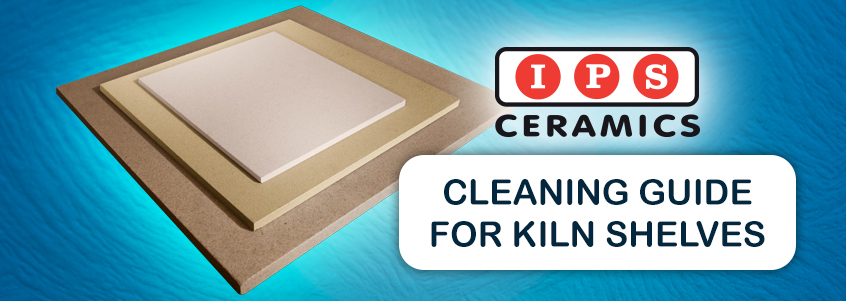IPS Ceramics understands that maintaining your kiln shelves is an extremely important part of glost firing. Neglected shelves (also known as batts and tiles) can result in flakes of wash getting onto your beautifully glazed surfaces or can cause kiln ware to stick to shelves where the glaze has previously dripped.
To get the best life from your shelves, it is crucial to stay on top of cleaning tasks and to know how to apply a wash coating to your kiln furniture. This post will talk you through the process so you can keep your kiln in top condition.
How to Use Shelf Wash
Shelf wash (also called batt wash or kiln wash) is a sacrificial coating applied to the top surface of kiln furniture to reduce glaze build-up and minimise sticking problems. New shelves should have a wash coat applied before use – most people also reapply a wash coat at regular intervals to maximise protection.
Shelf wash is normally supplied as a dry powder that is mixed with water before use. The exact mixture and proportions will depend on the type of wash you’re using and how the wash is being applied (please follow the manufacturer’s instructions). Generally speaking, a thicker mix is used in circumstances where the wash is applied by brush or roller and a thinner mix is used when it’s applied via a spray booth.
It is much better to apply two-to-three thinner coats of wash rather than one thick coat, as it tends to peel on drying. Allow each coat to dry before applying the next one.
To reduce the risk of bits of wash falling onto your kiln ware placed below, the edges and underside of a shelf should not be coated in the wash.
If there are any issues with your wash, clean the kiln shelves and reapply the wash.
How to Clean Kiln Shelves
When loading any kiln, you should examine your kiln shelves carefully. If there are no glaze runs and the shelf wash is not flaking, no action is required.
Any loose or flaky shelf wash should be scraped from the shelves using a sturdy metal scraper or heavy wire brush. This can generate plenty of airborne dust so it is best to do this using an extraction booth if available. Where a booth is not available, you should always wear suitable PPE such as overalls and a dust mask.
Any serious accumulation of glaze residue must be removed from the shelf or furniture before it is re-used. Fired glaze is very hard, so the best way to remove any drips or runs is by grinding. For light grinding, a fibreglass-reinforced grinding disk works best. Heavier grinding and the levelling of irregular shelves will require a masonry-duty diamond or silicon carbide cup wheel. Again, this can generate plenty of airborne dust. It is best done in an extraction booth or with suitable PPE such as overalls and a dust mask.
For larger potteries, automated grinding systems are available that can clean large numbers of batts per day.
We do not recommend using a chisel to remove glaze contamination due to the risk of breaking the kiln furniture.
Need Help Cleaning Your Kiln Shelves
Any group or academic studio where people are using kilns and furnaces should make kiln furniture maintenance part of their standard routine.
If you have any questions about cleaning kiln shelves, please do not hesitate to contact IPS Ceramics today. We have a collective 250+ years of experience in ceramic technology, including design, material selection and manufacturing. Our team can quickly and expertly evaluate possible ceramic solutions to suit your specific needs, catering for a whole host of manufacturing, engineering and laboratory demands. You can also take a look at our instructions for batt wash use.
